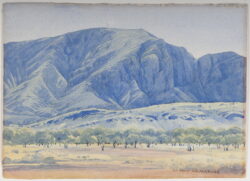 Albert Namatjira (1902-1959) was born near Hermannsburg, Northern Territory and was a Western Arrernte painter from the Central Desert region. He became a pioneer of contemporary Indigenous Australian art and is considered one of the most influential Arrernte painters. His work inspired the subsequent Hermannsburg School.
Albert Namatjira (1902-1959) was born near Hermannsburg, Northern Territory and was a Western Arrernte painter from the Central Desert region. He became a pioneer of contemporary Indigenous Australian art and is considered one of the most influential Arrernte painters. His work inspired the subsequent Hermannsburg School.
Albert Namatjira was raised at the remote Hermannsburg Lutheran Mission south west of Mparntwe (Alice Springs). He was interested in art when young, but it wasn’t until he was 32 that he began painting in watercolours under the guidance of artist Rex Battarbee.
Like many Indigenous people living in the Mission system of the time, he was subject to the assimilation policies of white Australia. Here, he learnt English and was baptised a Christian. When he was thirteen, he left the mission for six months and was taught traditional laws and customs by tribal elders as part of his initiation.[9]
Namatjira painted in a Western art-influenced style, depicting the landscapes of the outback in a highly detailed approach to watercolour. His work often depicted the rugged red-purple mountains and the stately white gums of his mother’s country around Palm Valley and his father’s country in the region of the MacDonnell Ranges. This was significantly different from the traditional approaches to art making of the central desert, which used symbols and abstract designs to tell stories about country. Namatjira was thought to have embraced European pictorial language over his own traditions, but his paintings express his close relationship with the lands he was a traditional custodian of, the Western Aranda (Arrernte) lands. His meticulous pictorial exploration of specific places and subtle understanding can be seen as an expression of his knowledge of traditional and sacred sites.[10]
Namatjira became one of Australia’s most famous artists. However, in his lifetime his success was interpreted by white society as an accomplishment of assimilation policies. He became the first Aboriginal person to be granted conditional Australian citizenship in 1957. He was also allowed to buy alcohol, which was illegal for Aboriginal people at the time. In 1958, after an incident that Namatjira wasn’t directly involved in, he was sentenced to six months in prison for supply of alcohol. He served only two months after an appeal, but his incarceration caused him profound anguish. He died shortly afterwards at the age of 57.
[9]“Portrait of a Nation, Australian Schools Project, Albert Namatjira,” National Portrait Gallery, accessed 12 March 2023, https://www.portrait.gov.au/portraitofanation/namatjira-biography.html
[10]“Albert Namatjira,” Art Gallery of New South Wales, accessed 12 March 2023, https://www.artgallery.nsw.gov.au/collection/artists/namatjira-albert/
Art making activity – Watercolour painting
Today we are going to make a painting using watercolour paints, the medium that Albert Namatjira used.
Guiding Instructions
- Make a drawing on the watercolour paper. Make sure that this image is drawn lightly.
- Mix the watercolours with water and apply to the paper. Try and apply the colours in separate sections.
- Watercolours work in different ways. If you apply them to dry paper they don’t move across the paper very much. If you wet the paper first, you will get a wash effect. Try both approaches. Be aware that if the paper is already wet, the paint colours will blend into one another.

Materials

Watercolour paints
Watercolour paper
Watercolour brushes
Containers for water
Palettes
Pencil and erasers for drawing the image
Image credit: Albert Namatjira, A Macdonnell Range Creek, 1944, Watercolour on paper, Gift of Howard Hinton, 1945
This program was funded by the NSW Government.
